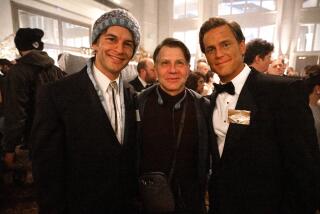The Sins of the Preacher : FORGIVEN The Rise and Fall of Jim Bakker and the PTL Ministry <i> by Charles E. Shepard (Atlantic Monthly Press: $22.95; 656 pp.; 0-87113-293-1)</i>
If Judge Robert “Maximum Bob” Potter, who recently presided over the trial of Jim Bakker, passes sentence on the basis of this book, Bakker will be confined to prison until the Lord returns. And if the Lord reads this book before He returns, Jim Bakker may want to stay in prison.
Charles E. Shepard became a reporter for the Charlotte Observer in 1978 and from 1984 through 1987 he tracked Bakker and the sprawling PTL ministry. Shepard broke the Jessica Hahn story; his probing of PTL’s financial misdeeds helped to topple the ministry in 1987 and won Pulitzer Prizes for him and his paper.
In the months leading up to the scandal, Shepard was titillated by tipsters, misled and threatened by insiders, and bridled by his responsible superiors in the Observer editorial office--the kind of treatment that hones the obsessive personalities that God gave to investigative reporters. He continued to collect and assimilate information for months after Bakker resigned, and this book is a detailed chronological recitation of his research. While Shepard gives more biographical information on Bakker than one will find elsewhere, about 90% of the book discusses the years after the Bakkers moved to Charlotte and began building the PTL empire in 1974.
The rise and fall of the PTL ministry is a complicated story, played out over nearly 15 years of triumph and tragedy. Shepard’s book is a Columbo-type mystery; you know the villain, but the evidence has to be painstakingly assembled. “Forgiven” is, in fact, classic mystery, filled with enough suspense to keep the attention of a reading public that must be jaded on preacher scandals. It is a skillful piece of writing.
Of course, the Bakker story provides ample material for a good mystery--sex, money, power plays, cover-ups and lying, disgusting and shady characters and a few heroes. Shepard’s coup as a reporter was documenting Bakker’s moment of unspiritual rapture with Hahn in a Clearwater Beach, Fla., hotel in December, 1980, but his book is laced with the sordid details of Bakker’s homosexual trysts and his fondness for masturbation as well as Tammy’s passion for other men. Most of the book, however, is a long, but never boring, account of the organizational chaos and financial irresponsibility that landed Bakker and his cronies in court, and the contortions of PTL’s leaders that kept the critics at bay for a decade.
The Bakker story falls into three segments. In the first 60 pages of this book, Shepard describes Bakker’s journey from a star-struck Pentecostal youth in Muskegon, Mich., to a traveling Pentecostal evangelist accompanied by his wife, Tammy, to a religious television personality chafing under the domination of Pat Robertson and Paul Crouch. In 1975, Bakker moved to Charlotte and gained control of the PTL, and for the next five years his ministry expanded dramatically. PTL’s success came partly because of Bakker’s talents as a television personality, and partly because, as with other religious television entrepreneurs, he profited from the expansion of cable television. During these years, Bakker survived an FCC investigation of his deceptive fund-raising tactics, aided by the favorable political climate for religious conservatives in the wake of the 1980 election.
The decade of the 1980s was filled with ecstasy and agony for Jim and Tammy Bakker. “The year 1981 was a watershed for the rationalization of greed at PTL,” writes Shepard, noting that the earnings of the Bakkers rose to $115,899 in 1981, to more than $420,000 the next year and more than $675,000 in 1983.
The tasteless extravagance of the Bakkers and PTL’s other leaders seemed to escalate in proportion to the financial and legal distress of the ministry, climaxing in a feeding frenzy as the day of reckoning approached. While PTL’s gaudy success was taken by insiders as proof of God’s approval, the ministry constantly tottered on the edge of financial collapse and the Bakkers’ private lives turned increasingly troubled and tragic.
The most portentous changes at PTL in the 1980s were in the ministry’s leadership. Prior to 1980, Bakker recruited and lost a series of responsible and ethical managers who tried to take the advice of competent lawyers and accountants. But Bakker was irresistibly drawn to power, he wanted freedom to follow the leading of the Holy Spirit. One by one his principled chaperons left, disillusioned or disgusted.
The cast of characters surrounding the Bakkers in the final years included the talented but profane evangelist John Wesley Fletcher, who orchestrated the Hahn affair and later claimed to have had sexual relations with Jim Bakker, and David and James Taggart, talented and stylish young men who fabricated a genteel family history. David Taggart, a bright and courteous executive with “distinctly effeminate” manners, wielded enormous power in the PTL organization and diverted huge sums of money to his brother and himself. When Taggart was asked under oath whether he had sexual relations with Bakker, his attorney invoked the Fifth Amendment.
Many thought that the reputations of Bakker and PTL might be salvaged by the appointment of Richard Dortch to the board in 1979 and his acceptance of an executive position in 1984. Dortch was a respected leader in the Assemblies of God and his skill in deflecting investigations saved Bakker’s hide for months. In the end, Dortch became, in lawyer Roy Grutman’s words, “an unmitigated liar,” the chief architect of a payoff to coverup the Hahn affair, and a confessed felon. Dortch takes center stage in the closing third of this book, and his moral collapse is as intriguing as that of Bakker.
There are several smaller stories within this story. Among the other television evangelists, Jimmy Swaggart, Paul Ankerberg and Jerry Falwell played crucial, and apparently honorable, roles in bringing PTL to account. The leaders of the Assemblies of God, Bakker’s denomination, ducked responsibility for month after month, although Shepard credits the church with finally facing the issue squarely. Finally, there is the soul-searching at the Charlotte Observer, publishers and editors worrying about fairness and popularity balancing reporters who had whiffed the stink of corruption. In the end, the Observer did the job on Bakker.
Shepard’s fine book only begins to explore the personality of Bakker. He believes that Bakker has a “narcissistic personality disorder,” causing him to crave adulation but shun personal intimacy. Many insiders considered Bakker a creative genius whose success proved his spirituality. The theology behind it may be grotesque, but building a Christian theme park was an idea so ripe for success that it took incompetence and greed on a grand scale to ruin it. However, Bakker’s best ideas, argues Shepard, were shamelessly borrowed from Pat Robertson and Walt Disney.
Shepard is least apt when discussing Bakker’s religious beliefs, although he tries to understand the Pentecostal mind-set. Bakker is part of a religious subculture in which faith is more important than reality. Shepard catches this mind-set when he describes Bakker’s effort to explain to the Federal Communications Commission that the untruths he told on television were actually true because they were spoken in faith. Bakker becomes possible, and believable, only if one imagines that in the remote recesses of his mind Bakker actually believed that he and his outrageous conduct had the stamp of divine approval.
It is not a major distraction that this book was published before Bakker has exhausted the appeals process. The trial may not be finished, but the PTL story is. It is a ribald, repugnant and extremely sad tale. Shepard’s telling of it is well worth reading.
More to Read
Sign up for our Book Club newsletter
Get the latest news, events and more from the Los Angeles Times Book Club, and help us get L.A. reading and talking.
You may occasionally receive promotional content from the Los Angeles Times.









